레스터 속성 대화창¶
To view and set the properties for a raster layer, double click on the layer name in the map legend, or right click on the layer name and choose Properties from the context menu. This will open the Raster Layer Properties dialog.
이 대화창에는 다음과 같은 탭들이 있습니다:
팁
실시간 렌더링 업데이트
레이어 스타일 작업 패널 은 레이어 속성 대화창의 공통 기능 가운데 일부를 제공하며, 레이어 스타일 환경 설정을 빠르게 할 수 있고 맵 캔버스에 사용자 변경 사항을 자동적으로 표시할 수 있는 훌륭한 모달리스 위젯입니다.
참고
원본 프로젝트 파일에서 삽입 레이어(프로젝트 내포 작업 참조)의 속성들(심볼, 라벨, 액션, 기본값, 양식 등등)을 읽어오기 때문에, 이 습성을 방해할 수도 있는 변경 사항이 적용되는 일을 피하기 위해 삽입 레이어에 대해 레이어 속성 대화창을 사용할 수 없게 돼 있습니다.
Information Properties¶
The  Information tab is read-only and represents an interesting
place to quickly grab summarized information and metadata on the current layer.
Provided information are:
Information tab is read-only and represents an interesting
place to quickly grab summarized information and metadata on the current layer.
Provided information are:
based on the provider of the layer (format of storage, path, data type, extent, width/height, compression, pixel size, statistics on bands, number of columns, rows and no-data values of the raster…);
picked from the filled metadata: access, links, contacts, history… as well as data information (CRS, Extent, bands…).
Source Properties¶
The  Source tab displays basic information about the selected
raster, including:
Source tab displays basic information about the selected
raster, including:
the Layer name to display in the Layers Panel;
setting the Coordinate Reference System: Displays the layer’s Coordinate Reference System (CRS) as a PROJ.4 string. You can change the layer’s CRS, selecting a recently used one in the drop-down list or clicking on
 Select CRS button (see 좌표계 선택기).
Use this process only if the CRS applied to the layer is a wrong one or if none
was applied. If you wish to reproject your data into another CRS, rather use
layer reprojection algorithms from Processing or Save it into another
layer.
Select CRS button (see 좌표계 선택기).
Use this process only if the CRS applied to the layer is a wrong one or if none
was applied. If you wish to reproject your data into another CRS, rather use
layer reprojection algorithms from Processing or Save it into another
layer.
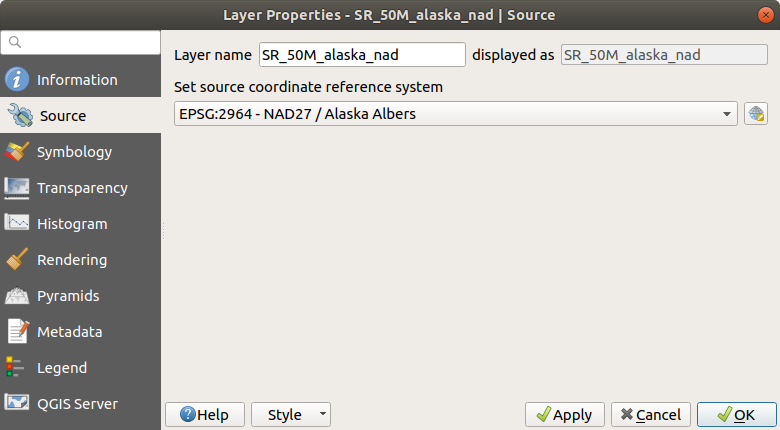
Raster Layers - Source Properties Dialog¶
Symbology Properties¶
밴드 렌더링¶
QGIS는 서로 다른 Render types 4개를 제공하고 있습니다. 데이터 유형에 따라 렌더링 작업자가 선택됩니다.
Multiband color - if the file comes as a multiband with several bands (e.g., used with a satellite image with several bands).
Paletted/Unique values - for single band files that come with an indexed palette (e.g., used with a digital topographic map) or for general use of palettes for rendering raster layers.
Singleband gray - (one band of) the image will be rendered as gray; QGIS will choose this renderer if the file has neither multibands nor an indexed palette nor a continuous palette (e.g., used with a shaded relief map).
Singleband pseudocolor - this renderer is possible for files with a continuous palette, or color map (e.g., used with an elevation map).
Hillshade - Creates hillshade from a band.
Multiband color¶
With the multiband color renderer, three selected bands from the image will be rendered, each band representing the red, green or blue component that will be used to create a color image. QGIS automatically fetches Min and Max values for each band of the raster and scales the coloring accordingly. You can control the value ranges with the help of the Min/Max Value Settings section.
A Contrast enhancement method can also be applied to the values: 〈No enhancement〉, 〈Stretch to MinMax〉, 〈Stretch and clip to MinMax〉 and 〈Clip to min max〉.
참고
대조 개선
GRASS 래스터를 추가하면, QGIS 일반 옵션에서 어떤 값으로 설정돼 있건 상관없이, 자동적으로 Contrast enhancement 옵션이 항상 stretch to min max 로 설정될 것입니다.
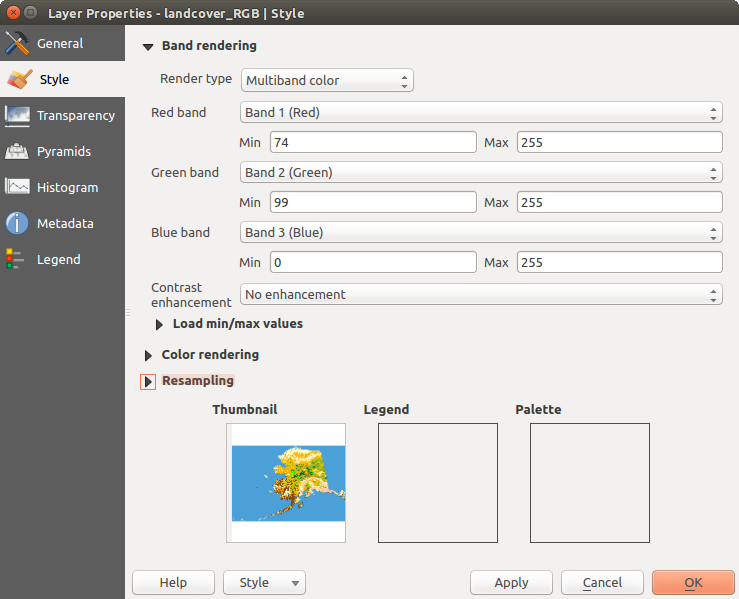
Raster Symbology - Multiband color rendering¶
팁
다중 밴드 래스터의 단일 밴드 살펴보기
If you want to view a single band of a multiband image (for example, Red), you might think you would set the Green and Blue bands to Not Set. But this is not the correct way. To display the Red band, set the image type to Singleband gray, then select Red as the Gray band to use.
Paletted/Unique values¶
This is the standard render option for singleband files that include a color table, where a certain color is assigned to each pixel value. In that case, the palette is rendered automatically.
It can be used for all kinds of raster bands, assigning a color to each unique raster value.
If you want to change a color, just double-click on the color and the Select color dialog appears.
It is also possible to assign labels to the colors. The label will then appear in the legend of the raster layer.
Right-clicking over selected rows in the color table shows a contextual menu to:
Change Color… for the selection
Change Opacity… for the selection
Change Label… for the selection
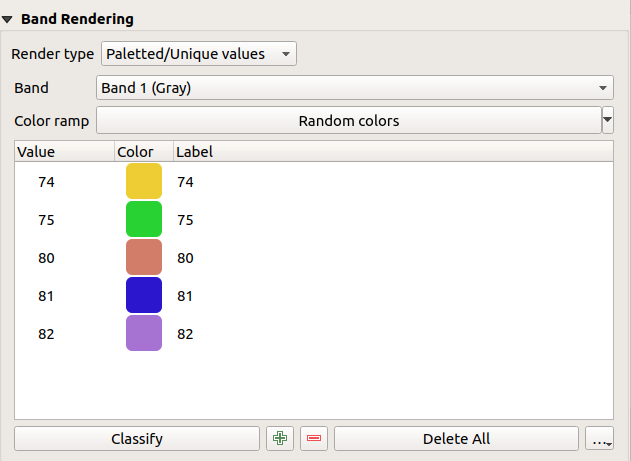
Raster Symbology - Paletted unique value rendering¶
The pulldown menu, that opens when clicking the … (Advanced options) button below the color map to the right, offers color map loading (Load Color Map from File…) and exporting (Export Color Map to File…), and loading of classes (Load Classes from Layer).
Singleband gray¶
This renderer allows you to render a single band layer with a Color gradient: 〈Black to white〉 or 〈White to black〉. You can define a range of values to color other than the default Min and Max values of the whole raster, thanks to the Min/Max Value Settings option.
Again, a Contrast enhancement method can be applied to the values: 〈No enhancement〉, 〈Stretch to MinMax〉, 〈Stretch and clip to MinMax〉 and 〈Clip to min max〉.
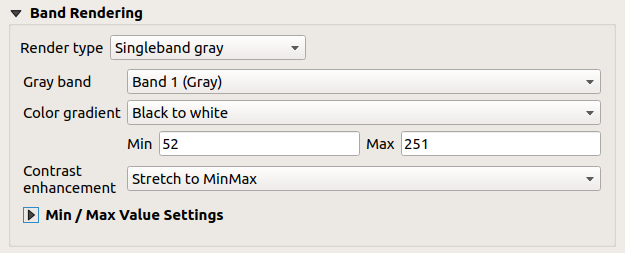
Raster Symbology - Singleband gray rendering¶
Singleband pseudocolor¶
This is a render option for single-band files that include a continuous palette. You can also create color maps for a bands of a multiband raster.
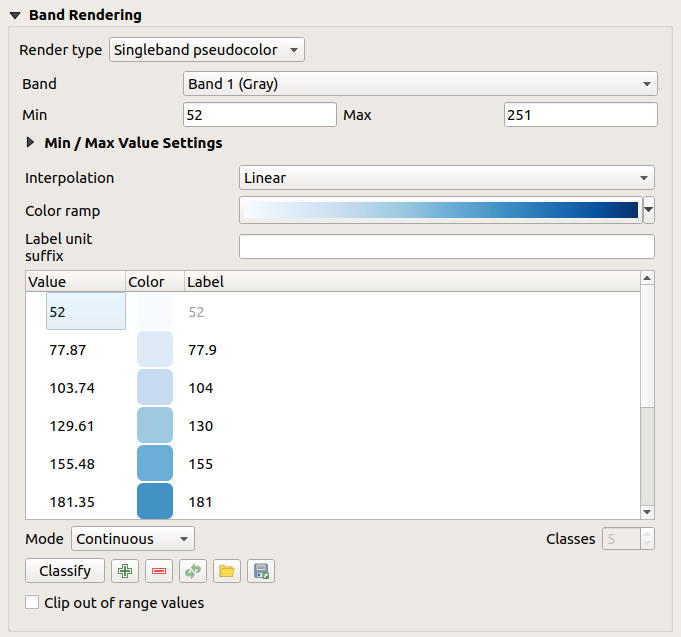
Raster Symbology - Singleband pseudocolor rendering¶
Using a Band of the layer and a values range, three types of color Interpolation are available:
Discrete (a <= symbol appears in the value column)
선형(Linear)
Exact (an equal symbol appears in the Value column)
The Color ramp drop down list lists the color ramp in your QGIS. You can add a new one, edit or save the one you changed. The name of the color ramp will be saved in the configuration and in the QML files.
The Label unit suffix is a label added after the value in the legend.
For the classification Mode  〈Equal interval〉, you
only need to select the number of classes
〈Equal interval〉, you
only need to select the number of classes  and press
the button Classify.
In the case of the Mode
and press
the button Classify.
In the case of the Mode  〈Continuous〉, QGIS creates
classes automatically depending on the Min and Max.
〈Continuous〉, QGIS creates
classes automatically depending on the Min and Max.
The button  Add values manually adds a value
to the individual color table. The button
Add values manually adds a value
to the individual color table. The button  Remove selected row
deletes a value from the individual color table. Double clicking on the value column
lets you insert a specific value. Double clicking on the color column opens the dialog
Change color, where you can select a color to apply on that value.
Further, you can also add labels for each color, but this value won’t be displayed
when you use the identify feature tool.
Remove selected row
deletes a value from the individual color table. Double clicking on the value column
lets you insert a specific value. Double clicking on the color column opens the dialog
Change color, where you can select a color to apply on that value.
Further, you can also add labels for each color, but this value won’t be displayed
when you use the identify feature tool.
Right-clicking over selected rows in the color table shows a contextual menu to:
Change Color… for the selection
Change Opacity… for the selection
You can use the buttons  Load color map from file
or
Load color map from file
or  Export color map to file to load an existing
color table or to save the color table for later use.
Export color map to file to load an existing
color table or to save the color table for later use.
The  Clip out of range values allows QGIS to not render pixel
greater than the Max value.
Clip out of range values allows QGIS to not render pixel
greater than the Max value.
Hillshade¶
Render a band of the raster layer using hillshading.
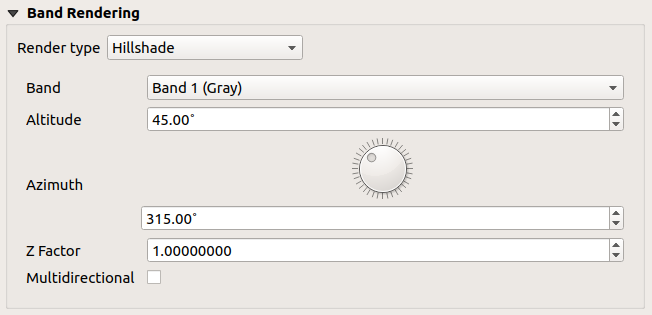
Raster Symbology - Hillshade rendering¶
Options:
Band: The raster band to use.
Altitude: The elevation angle of the light source (default is
45°).Azimuth: The azimuth of the light source (default is
315°).Z Factor: Scaling factor for the values of the raster band (default is
1). Multidirectional: Specify if multidirectional hillshading
is to be used (default is
Multidirectional: Specify if multidirectional hillshading
is to be used (default is off).
Setting the min and max values¶
By default, QGIS reports the Min and Max values of the band(s) of the raster. A few very low and/or high values can have a negative impact on the rendering of the raster. The Min/Max Value Settings menu helps you control the values to render.
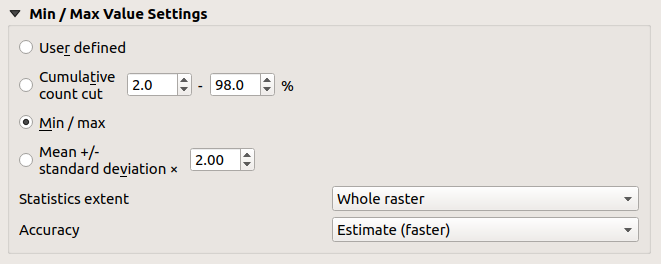
Raster Symbology - Min and Max Value Settings¶
Available options are:
 User defined: The default
Min and Max values of the band(s) can be overridden
User defined: The default
Min and Max values of the band(s) can be overridden Cumulative count cut: Removes outliers.
The standard range of values is
Cumulative count cut: Removes outliers.
The standard range of values is 2%to98%, but can be adapted manually. Mean +/- standard deviation x: Creates a color
table that only considers values within the standard deviation or within multiple
standard deviations. This is useful when you have one or two cells with abnormally
high values in a raster grid that are having a negative impact on the rendering
of the raster.
Mean +/- standard deviation x: Creates a color
table that only considers values within the standard deviation or within multiple
standard deviations. This is useful when you have one or two cells with abnormally
high values in a raster grid that are having a negative impact on the rendering
of the raster.
Calculations of the min and max values of the bands are made based on the:
Statistics extent: it can be Whole raster, Current canvas or Updated canvas. Updated canvas means that min/max values used for the rendering will change with the canvas extent (dynamic stretching).
Accuracy, which can be either Estimate (faster) or Actual (slower).
참고
For some settings, you may need to press the Apply button of the layer properties dialog in order to display the actual min and max values in the widgets.
색상 렌더링¶
모든 Band rendering 에 대해, Color rendering 도 할 수 있습니다.
혼합 모드 가운데 하나를 사용해서 사용자 래스터 파일(들)에 특별 렌더링 효과를 줄 수도 있습니다. (혼합 모드 를 참조하세요.)
Brightness 옵션으로 명도를, Saturation 옵션으로 채도를, Contrast 옵션으로 대조를 조정해서 색상을 심화 설정할 수도 있습니다. 또 Grayscale 옵션도 사용할 수 있는데, 〈By lightness〉, 〈By luminosity〉 및 〈By average〉 가운데 하나를 선택할 수 있습니다. 색상표에 있는 색채(hue) 하나를 선택한 다음 해당 색채의 Strength 를 조정할 수 있습니다.
리샘플링¶
Resampling 옵션은 사용자가 이미지를 확대/축소하는 경우 나타납니다. 리샘플링 모드로 맵의 모습을 최적화할 수 있습니다. 리샘플링 모드들은 기하학적 변형을 통해 새 회색조 값 매트릭스를 생성합니다.
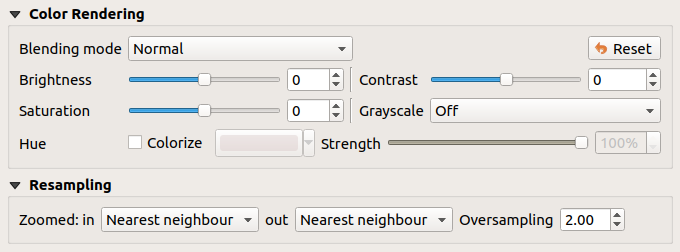
Raster Symbology - Color rendering and Resampling settings¶
〈Nearest neighbour〉 방법을 적용하면, 확대 시 맵의 픽셀이 두드러져 보일 수 있습니다. 〈Bilinear〉 또는 〈Cubic〉 방법을 사용하면 이 모습을 향상시킬 수 있는데, 이 방법들은 뚜렷한 피처를 흐릿하게 만듭니다. 이 블러 효과로 더 부드러운 이미지를 생성할 수 있습니다. 이 방법들은, 예를 들자면 래스터 수치지형도에 적용할 수 있습니다.
At the bottom of the Symbology tab, you can see a thumbnail of the layer, its legend symbol, and the palette.
투명도 속성¶
 QGIS has the ability to display each raster layer at a different transparency level.
Use the transparency slider
QGIS has the ability to display each raster layer at a different transparency level.
Use the transparency slider  to indicate to what extent the underlying layers
(if any) should be visible through the current raster layer. This is very useful
if you like to overlay more than one raster layer (e.g., a shaded relief map
overlayed by a classified raster map). This will make the look of the map more
three dimensional.
to indicate to what extent the underlying layers
(if any) should be visible through the current raster layer. This is very useful
if you like to overlay more than one raster layer (e.g., a shaded relief map
overlayed by a classified raster map). This will make the look of the map more
three dimensional.
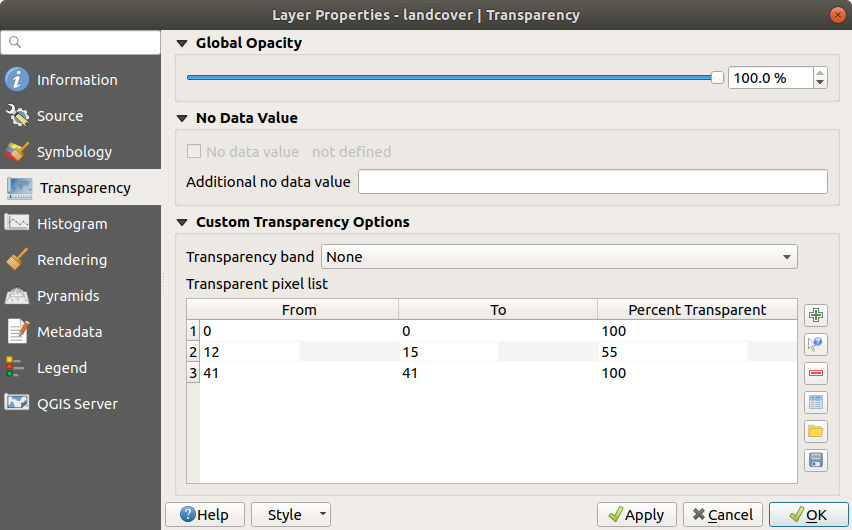
Raster Transparency¶
또한, Additional no data value 옵션에서 NODATA 로 처리돼야 할 래스터 값을 입력할 수 있습니다.
An even more flexible way to customize the transparency can be done in the Custom transparency options section:
Use Transparency band to apply transparency on an entire band.
Provide a list of pixels to make transparent with the corresponding level of transparency:
Enter the Red, Green and Blue values of the pixel and adjust the Percent Transparent to apply.
Alternatively, you can directly fetch the pixel values directly from the raster using the
 Add values from display button.
Then enter the transparency value.
Add values from display button.
Then enter the transparency value.Repeat the steps to adjust more values with custom transparency.
Press the Apply button and have a look at the map.
이처럼 사용자 지정 투명도를 설정하는 일은 꽤 쉬운 편이지만, 반복 작업을 오래 해야 할 수도 있습니다. 따라서,
 Export to file 아이콘을 이용해서 사용자의 투명도 목록을 파일로 저장할 수 있습니다.
Export to file 아이콘을 이용해서 사용자의 투명도 목록을 파일로 저장할 수 있습니다.  Import from file 아이콘은 사용자의 투명도 설정을 불러와 현재 래스터 레이어에 적용시킵니다.
Import from file 아이콘은 사용자의 투명도 설정을 불러와 현재 래스터 레이어에 적용시킵니다.
히스토그램 속성¶
The  Histogram tab allows you to view the distribution
of the bands or colors in your raster. The histogram is generated when you press the
Compute Histogram button. All existing bands will be displayed together.
You can save the histogram as an image with the
Histogram tab allows you to view the distribution
of the bands or colors in your raster. The histogram is generated when you press the
Compute Histogram button. All existing bands will be displayed together.
You can save the histogram as an image with the  button.
button.
At the bottom of the histogram, you can select a raster band in the drop-down
menu and Set min/max style for it.
The  Prefs/Actions drop-down menu gives you advanced
options to customize the histogram:
Prefs/Actions drop-down menu gives you advanced
options to customize the histogram:
With the Visibility option, you can display histograms of the individual bands. You will need to select the option
 Show selected
band.
Show selected
band.The Min/max options allow you to 〈Always show min/max markers〉, to 〈Zoom to min/max〉 and to 〈Update style to min/max〉.
The Actions option allows you to 〈Reset〉 or 〈Recompute histogram〉 after you changed the min or max values of the band(s).
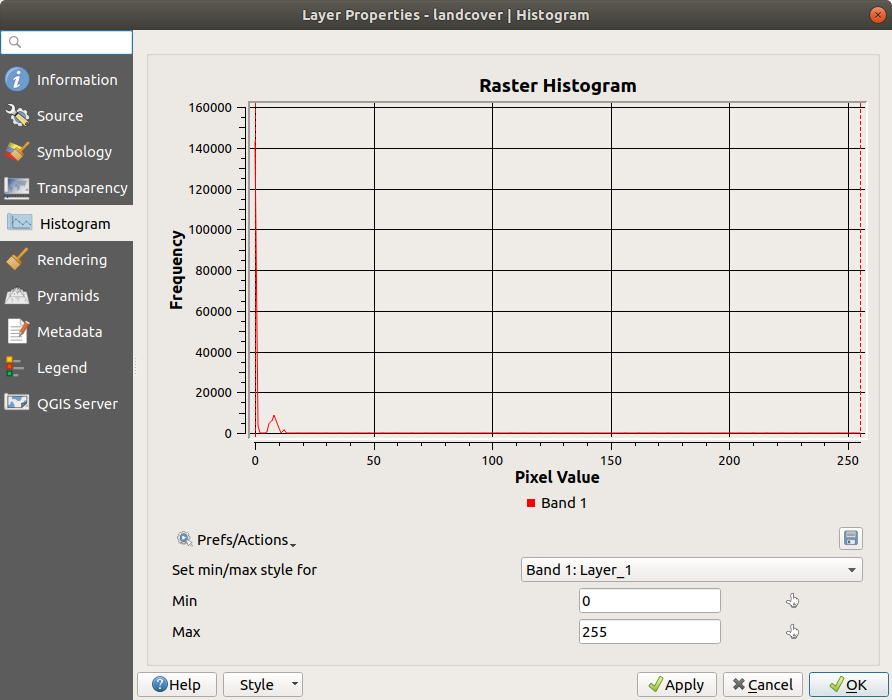
래스터 히스토그램¶
Rendering Properties¶
In the  Rendering tab, it’s possible to:
Rendering tab, it’s possible to:
apply a Scale dependent visibility to the layer: You can set the Maximum (inclusive) and Minimum (exclusive) scale, defining a range of scale in which the layer will be visible. Out of this range, it’s hidden. The
 Set to current canvas scale button helps you use the current map
canvas scale as boundary of the range visibility.
See 축척에 따른 렌더링 for more information.
Set to current canvas scale button helps you use the current map
canvas scale as boundary of the range visibility.
See 축척에 따른 렌더링 for more information.Refresh layer at interval (seconds): set a timer to automatically refresh individual layers at a matching interval. Canvas updates are deferred in order to avoid refreshing multiple times if more than one layer has an auto update interval set.
Maximum (inclusive) 및 Minimum (exclusive) 축척을 설정해서 레이어가 보이게 될 축척 범위를 정의할 수 있습니다. 이 범위를 벗어나면, 레이어를 숨깁니다.  Set to current canvas scale 버튼을 클릭하면 현재 맵 캔버스의 축척을 가시성 범위의 한계값으로 설정할 수 있습니다. 자세한 내용은 축척에 따른 렌더링 을 참조하세요.
Set to current canvas scale 버튼을 클릭하면 현재 맵 캔버스의 축척을 가시성 범위의 한계값으로 설정할 수 있습니다. 자세한 내용은 축척에 따른 렌더링 을 참조하세요.
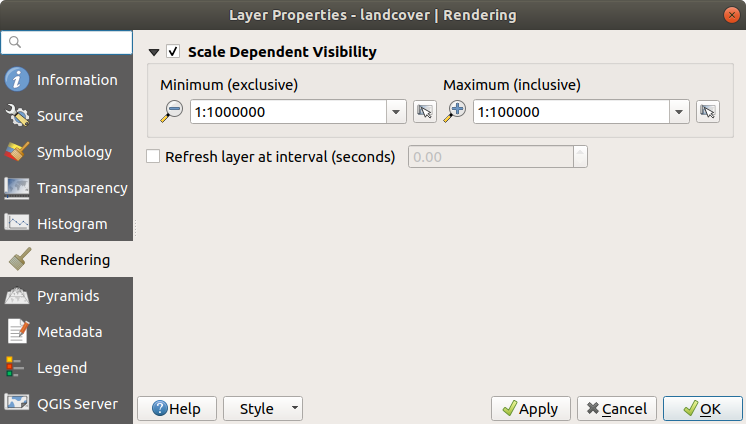
Raster Rendering¶
피라미드 속성¶
고해상도 래스터 레이어는 QGIS의 맵 탐색 속도를 느리게 할 수 있습니다. 이때 더 낮은 해상도를 가진 데이터 복사본들(피라미드)을 생성하면, QGIS가 확대/축소 수준에 따라 가장 알맞은 해상도를 선택하기 때문에 성능을 크게 개선할 수 있습니다.
피라미드를 생성하려면 원본 데이터가 저장돼 있는 디렉터리에 쓰기 권한을 가지고 있어야만 합니다.
Resolutions 목록에서, 해상도를 클릭해서 피라미드를 생성하려는 해상도를 선택하십시오.
Overview format 드롭다운 목록에서 Internal (if possible) 을 선택한 경우, QGIS는 피라미드를 원본 파일 내부에 생성하려 할 것입니다.
참고
피라미드 생성 작업이 원본 데이터 파일을 변경시킬 수도 있으며, 생성 후엔 제거할 수 없다는 점을 기억하십시오. 사용자 래스터의 〈피라미드가 아닌〉 버전을 보존하고 싶다면, 피라미드를 생성하기 전에 백업하십시오.
External 및 External (Erdas Imagine) 을 선택한 경우, 원본 래스터 파일이 있는 디렉터리에 피라미드를 동일한 파일명과 .ovr 확장자를 가진 파일로 생성할 것입니다.
피라미드를 계산하는 데 다음 몇몇 Resampling methods 를 사용할 수 있습니다:
Nearest Neighbour
Average
Gauss
Cubic
Cubic Spline
Laczos
Mode
None
Finally, click Build Pyramids to start the process.
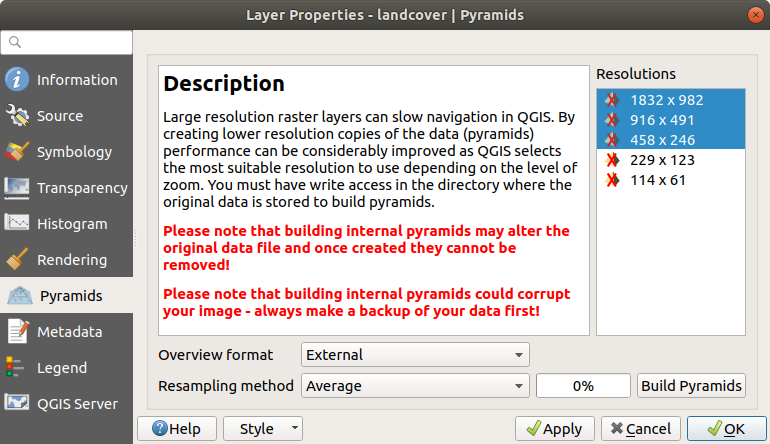
래스터 피라미드¶
메타데이터 속성¶
The  Metadata tab provides you with options to create
and edit a metadata report on your layer. See vector layer metadata
properties for more information.
Metadata tab provides you with options to create
and edit a metadata report on your layer. See vector layer metadata
properties for more information.
범례 속성¶
The  Legend tab provides you with a list of widgets you can
embed within the layer tree in the Layers panel. The idea is to have a way to
quickly access some actions that are often used with the layer (setup
transparency, filtering, selection, style or other stuff…).
Legend tab provides you with a list of widgets you can
embed within the layer tree in the Layers panel. The idea is to have a way to
quickly access some actions that are often used with the layer (setup
transparency, filtering, selection, style or other stuff…).
QGIS가 기본적으로 투명도 위젯을 제공하고는 있지만, 플러그인의 자체 위젯을 등록하고 플러그인이 관리하는 레이어에 사용자 지정 액션을 할당하면 위젯 목록을 확장할 수 있습니다.
QGIS Server Properties¶
The  QGIS Server tab displays a wealth of information about
the raster layer, including statistics about each band in the current raster layer.
From this tab, entries may be made for the Description,
Attribution, MetadataUrl and Properties.
In Properties, statistics are gathered on a 〈need to know〉
basis, so it may well be that a given layer’s statistics have not yet been
collected.
QGIS Server tab displays a wealth of information about
the raster layer, including statistics about each band in the current raster layer.
From this tab, entries may be made for the Description,
Attribution, MetadataUrl and Properties.
In Properties, statistics are gathered on a 〈need to know〉
basis, so it may well be that a given layer’s statistics have not yet been
collected.
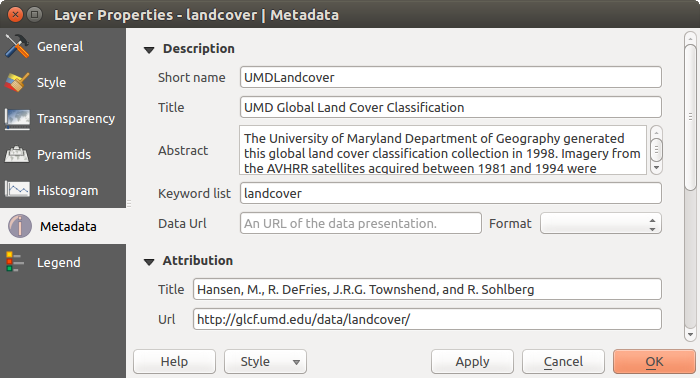
QGIS Server in Raster Properties¶


